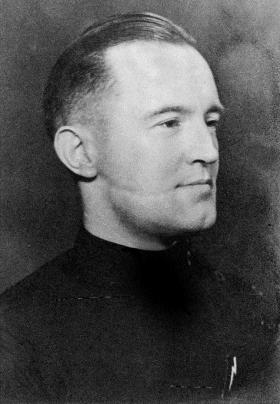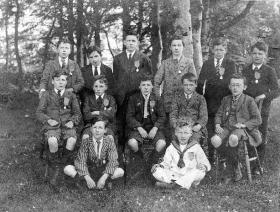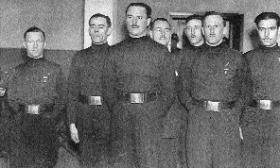TV Eye
Published in Book Reviews, Issue 4 (Jul/Aug 2005), Reviews, Volume 13Hitler’s Irishman; the story of Lord Haw-Haw
RTÉ 1
Written and directed by Martin Gilbert
By Eamon O’Flaherty

William Joyce in the Blackshirt uniform of the British Union of Fascists. (The Friends of Oswald Mosley)
Ireland’s flirtation with Fascism and Nazism took many forms in the period between the rise of Mussolini and the end of the Second World War. There was considerable admiration for Italian Fascism in both Britain and Ireland during the 1920s. The superficial similarities between the Blueshirts and the shirted Fascist movements of the inter-war period are perhaps more apparent than real. The links between the IRA and Nazi Germany, especially in the figure of Seán Russell, were explored by Brian Hanley in the last issue of History Ireland. Apart from the opportunistic alliance with Britain’s enemy, during the war period the IRA displayed anti-communist and anti-Semitic tendencies which would have made it a fitting collaborator with a German regime in the unlikely event of a successful German invasion of Britain. The figure of William Joyce, the most famous Irish Nazi, adds another layer of complexity to this aspect of Irish involvement with Fascism and Nazism.
Born in 1906 in New York, Joyce’s family moved to Galway when he was three and he was educated at St Ignatius’s Jesuit college. Like many Irish ideologues of the period, Joyce was politicised by the War of Independence. Unusually, Joyce’s family remained loyal to the Union throughout, and the film suggested that his attitudes were formed in his early teens by consorting with Black and Tans. This led to a death threat from the local IRA, which forced Joyce to escape to London when he was not yet sixteen. There he quickly became involved in right-wing street politics, often involving violent clashes at public meetings with communist militants. At one such meeting, organised in support of a Conservative election candidate, Joyce was slashed by a razor that left him with a livid scar disfiguring his face. This doubtless added to his credentials on the violent fringes of British Fascism, but Joyce’s career on the extreme right was also buttressed by his articulate commitment to racism, imperialism and anti-Semitism. Tim Pat Coogan suggested that some of his intensity derived from the sense of betrayal felt by southern Irish loyalists after 1922.
Joyce was bright enough to have pursued a conventional academic career. In 1928 he took a first-class degree in English literature from London University and was making a living as a university tutor in the early 1930s. The founding of the British Union of Fascists (BUF) by Oswald Mosley in 1932 led Joyce to abandon academic life for a career as a full-time Blackshirt activist. He quickly rose to prominence in the BUF, becoming deputy leader and head of propaganda—a position that enlisted his remarkable talents as a mob orator and his commitment to the ideology of the anti-Semitic and anti-communist right. Capable of speaking for up to four hours without flagging—whatever about his audience—Joyce was serving an apprenticeship for a career that was to flourish in Germany during the war.
It was a measure of Joyce’s extremism that he proved too radical for the BUF. A photograph of 1936 shows Joyce cultivating an Adolf Hitler image, complete with toothbrush moustache, floppy fringe and brown shirt—the sinister scar was also prominent. Under increasing pressure from the left and the British authorities, and seeking to reverse the decline in his movement, Mosley expelled Joyce from the movement in 1937. Joyce’s rather chaotic private life, characterised by womanising and heavy drinking, may also have been a factor in his isolation from the movement in the immediate pre-war years. By 1939, having quarrelled with his former comrades and facing probable internment as war loomed, he narrowly escaped arrest by moving to Berlin with his second wife, Margaret, a week before the outbreak of war. Here he discovered that promises of propaganda work evaporated, but he secured an audition for German radio through the efforts of Dorothy Eckersly, a British supporter of Hitler. He very quickly became the

At St Ignatius College in Galway: a Confirmation picture taken in 1915 or 1916. ‘Willie Joyce’ is third from the right in the back row.
English voice of Nazi Germany, broadcasting right up to the day of Hitler’s suicide in April 1945.
Recordings of Joyce’s broadcasts and reminiscences by Brian Farrell, a schoolboy living in Dublin at the time, and by Joyce’s daughter, who never saw him after 1935, were very evocative. The nickname ‘Lord Haw-Haw’ derived from the upper-class tones of his plummy Anglicised accent—although listening to them at this remove it is hard to hear that they
were very different from many Irish voices preserved on sound recordings of the period. The idea that he was a fake was a deeply effective and revealing piece of counter-propaganda and reveals a major contradiction in Joyce’s identity—here was an Irishman who believed in the Union and the empire but was regarded as a phoney Englishman, serving Britain’s enemies while proclaiming his concern for the real interests of the British people to the very end.

On the platform of the British Union of Fascists. William Joyce, the fiery British Empire patriot.
The distinguished group of historians and biographers, notably Mary Kenny, Peter Hartland and Terry Charman, offered an interesting analysis of Joyce’s career as a Nazi propagandist. By 1940 Joyce had a daily slot called ‘Views on the News’ that was estimated to have seven million daily listeners and eighteen million regular listeners. The conditions of the ‘phoney war’, the novelty of hearing the political establishment attacked on radio, especially given the radical anti-capitalist gloss of Nazi propaganda, and the dismal fare offered by the BBC—endless ministerial statements and hours of insipid organ music—probably contributed to the huge audience that he built up in the first year of the war. After the fall of France and the Blitz, fascination turned to hatred, but Lord Haw-Haw developed an almost superhuman reputation. Popular myths developed about his accurate predictions of where bombs would fall, but his gloating at the plight of Britain during the period between 1940 and the turn of the tide in 1942–3 sealed his fate as the defeat of Germany became inevitable. Joyce’s rackety lifestyle continued as Berlin was destroyed by the allied bombing offensive, and in his final broadcast on 30 April 1945, in which he warned Britain of the Soviet threat, Joyce was almost incapably drunk, the notorious accent battling through a fog of alcohol and slurred speech.

With the Blackshirts in 1934. Joyce is at the extreme left. Oswald Mosley is third from the left and in the centre of the group, looking over Mosley’s left shoulder, is Eric Hamilton Piercey, who would marry William’s first wife, Hazel, and become ‘a very good stepfather’ to William’s daughters. (The Friends of Oswald Mosley)
Joyce was a minor figure in the German war effort. He never met Hitler or Goebbels, but the range of experts marshalled in Brian Gilbert’s film testifies to the enduring nature of his symbolic importance. It was this symbolic value, the destruction of an icon of Nazism as much as any act of petty revenge, that led to his execution for treason in 1946. What is more surprising is the number of Irish and other European collaborators and sympathisers with Hitler who were rehabilitated and even honoured in the post-war world.
Eamon O’Flaherty lectures in history at University College Dublin
Pictures from Germany Calling by Mary Kenny, courtesy of New Island.
















